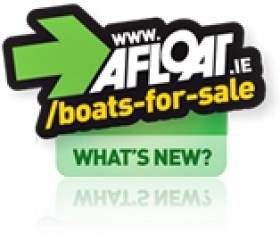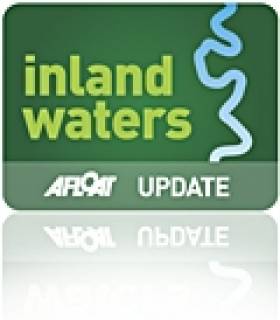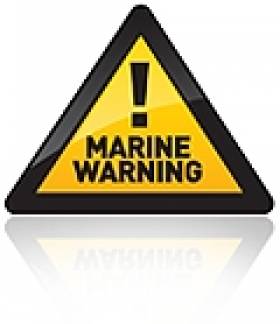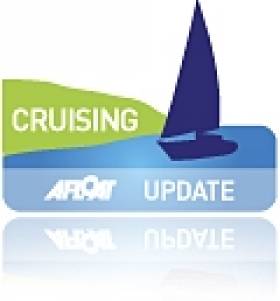Displaying items by tag: boat
'Temptress' Classic is New on our Boats For Sale Site
Sidewinder, 'A Well Maintained' Twister 28 Yacht, Goes Up for Sale
When Bangor yacht broker Lee Stevenson say it is 'a rare pleasure' to step aboard a yacht of and find her in such good order, its worth listening. That's the case with Sidewinder, a Twister 28 yacht that has just been added to Afloat's boats for sale site this week. 'The build quality is excellent and she's clean, tidy and well maintained – a credit not only to her current owners but to all of her previous owners and sailors' says Stevenson.
Fitted out in 1969 for a boat show, all of the joinery is completed to a very high standard and the interior is still in great condition. Sidewinder has just completed a circumnavigation of Ireland. The full spec inlcuding a downloadable file is here.
Our Boats for Sale website has been updated. We've listened to the needs of you, the buyers and sellers to bring you the site Ireland needs for boat trading.
Firstly, our aim is to generate Ireland's largest stock of quality boats for sale, in order to do this we've introduced a modest charge of €10 to list your boat for 60 days. We've simplified the steps involved to advertise your boat, and once you've walked through them here are some of the advantages your boat has to gain maximum exposure...
Your boat will be added to Ireland's largest boating mailing list with over 10,000 subscribers, giving your boat more exposure both at home and abroad
Bavaria 33 HT Motor Cruiser With Big Price Reduction
With a normal retail price well in excess of €250,000 O'Sullivan's marine of Tralee have just added a Bavaria 33 HT Sports Cruiser to the Afloat Boats for Sale site with a final price reduction on this Demo model. 'Going, going for - €125,0000 ex Vat' says the Kerry Yacht Broker. Check out the full listing on the boat here.
We want your boat!
Selling your sailing cruiser, motor boat, dinghy, speedboat or even your kayak?
Our Boats for Sale website has been updated. We've listened to the needs of you, the buyers and sellers to bring you the site Ireland needs for boat trading.
Firstly, our aim is to generate Ireland's largest stock of quality boats for sale, in order to do this we've introduced a modest charge of €10 to list your boat for 60 days. We've simplified the steps involved to advertise your boat, and once you've walked through them here are some of the advantages your boat has to gain maximum exposure...
Your boat will be added to Ireland's largest boating mailing list with over 10,000 subscribers, giving your boat more exposure both at home and abroad
- Your boat will be part of Ireland's largest marine portal site, having 3,000+ visitors per day
- Upload images, video, pdf spec list and google maps, helping overseas buyers establish transport arrangements etc
- Latest boats appear through a feed on every page of afloat.ie, there are 15000+ pages
- Facebook integration helps people 'share' your boat with more targeted buyers
- Your boat will be listed and tweeted to our 1,200 twitter followers and 2,200 Facebook fans
- Listing in Afloat magazine, Ireland's Boating and Sailing Magazine
New Offer to Pay Boat Insurance By the Month
Previously reserved for much higher premiums, the monthly payment option is available to both new and existing customers for no additional charge thanks to the highly automated nature of Craftinsure's online facility, underwritten by the Zurich Insurance Group.
The move is intended to help more owners in spreading their boating costs over the course of the whole year, whilst still keeping premiums as low as possibl, says Craft insure's Rod Danie. For more details www.craftinsure.ie or call Freefone 1800 844 100.
Underwater Survey at Portumna Castle Harbour
Waterways Ireland says the survey area is defined by coordinates:
|
Point |
Lat |
Long |
|
A |
53.083405 |
-8.220102 |
|
B |
53.082973 |
-8.21993 |
|
C |
53.08289 |
-8.219533 |
|
WGS84 decimal degrees |
||
The International Dive flag “A” (Blue / White) will be flown from the dive boat and marine vhf channel 16 will be monitored. The dive boat may also be contacted on 353-86-3859251.
Tipperary Boat Dealer 'Closes the Doors'
Tipperary Boat dealer Marine Action Boats Ltd, based on the river Shannon at Birdhill has 'ceased operations' according to an announcement on the firm's website. The Sports boat dealership 'closed its doors' and ceased trading on December 31 2010, according to managing director, Tadhg Foley. Marine Action Boats were sole importers of Crownline Sports Cruisers for Ireland, according to the website. The sports boat section of the marine trade market has been one of the hardest hit by the economic downturn. The firm also handled brokerage, repairs and boat maintenance. The full text of the announcement is as follows:
"Despite great efforts from ourselves and our loyal team, we would like to announce that we have ceased operations at Marine Action Boats, and we are no longer trading. We would also like to thank all our customers and our suppliers for their support over the past decade".
Launching? Check Your Boat Maintenance
"Many of the water-based incidents that we deal with at this time of year involve engine breakdown as a result of lack of maintenance," says Garry Hall of the UK's Solent Coastguard. "People report running out of fuel, sometimes because fuel indicators are broken or because fuel can't get through pipes and the engine is starved. Electrical issues are also a frequent problem. Often oxidation happens if engines are laid open to the elements and it affects the wiring. Engines are susceptible to frost so following our cold winter they will certainly need a good service."
Ideally attend a Diesel engine maintenance course, see:
www.rya.org.uk/coursestraining/courses/specialist/Pages/Diesel.aspx
Whilst you're considering maintenance, don't forget to look at your lifejackets and make sure that they are functioning fully. Remove the cylinders and auto-mechanisms, washing them in fresh water. Now inflate the lifejackets using a hand pump, leaving them for 24 hours to make sure that they don't deflate. Then reassemble the lifejacket, ensuring that the cylinder is screwed back in securely. The RNLI have some good advice about how to maintain your lifejacket on their website. Go to www.rnli.org.uk/seasafety
Appropriate and fully functioning communications equipment will be vital should you find yourself in an emergency situation. Have you got all the right equipment?
Check all your existing communication equipment. Ensure your VHF DSC radio unit's MMSI registration is up to date with Ofcom so that the Coastguard has the right emergency contact details. If you have an emergency position-indicating radio beacon (EPIRB) or a personal locator beacon (PLB), replace batteries before they expire and don't just rely on the "test" button. Also ensure the beacon's registration details are up to date so that the Coastguard has the right emergency contact details and correct information for both yourself and your vessel.
Celebrating the Three Sisters Navigation
This year we celebrate the 220th anniversary of the opening of the Barrow Navigation. This linked the Grand Canal with the rivers Barrow, Nore and Suir, and opened up a large area of the hinterland to the great ports of Dublin and Waterford. When the canals closed to commercial traffic in the 1960s it was feared that all use of the navigation would soon cease. Indeed, non-commercial traffic did become very light, but now, following excellent remedial works by Waterways Ireland we welcome a new era for this navigation, one which will bring new life and vitality to the waterway in the towns and villages along the system.
A hundred years ago, 1,200 boatmen were engaged in the business of transporting cargo, connecting people in inland towns with those in Irish ports, and in turn linking them with the great sea ports of the world. Today, many of their descendants live along our inland navigations.
Three of these great canal boats, numbers 72M, 68M and 107B, escorted by a flotilla of other HBA boats will, over the next few months, travel the entirety of the Navigation including Carlow, Waterford, Carrick on Suir, Inistioge and all points in between. The crews are anxious to meet with those whose families had connections with the commercial trade along the waterway, and perhaps even re-unite some long retired boatmen with their old boat.
The following are the expected arrival dates in various locations over the next few weeks:
° Carlow April 9th from 14.00
° Leighlinbridge April 16th from 14.00
° Bagenalstown April 24th from 13.00
Irish Cruising Club Present Fastnet Award to Killian Bushe
So whenever a high-powered strongly-resourced international challenge is taking shape, Bushe is the boat-builder of choice, favoured by leading designers and top skippers alike. But if you have a challenge in mind and he is top of the list, please join the queue.
For at the moment, he is immersed as leading consultant in building the new Groupama 4, the top French Volvo 70 for Franck Cammas. Before that, he built the two successful Ericsson boats for the last Volvo – they took first and fourth. In fact, he has built the overall winners of the last three Volvo races. And when Groupama 4 is launched in May and signed off for the race (which starts on October 29th) Bushe returns his focus to Sweden which is now his home, where he has been involved with the Artemis challenger for the America's Cup 2013.
For that project, the designer is Juan Kouyoumdjian, and the skipper is Paul Cayard. This is stratospheric stuff, but that's the level where Bushe operates. With more than thirty years of high tech boat building experience, and a string of success that is mind-boggling, he is the gold standard. But beyond that, he is still the Crosshaven kid who started his racing on his father George's Avocet (which George designed and built), and internationally he is the spirit of Cork sailing.
His renowned skill and knowledge in the use of advanced materials and composites is such that you'd expect him to be awarded a Honorary Doctorate in chemistry from some appropriate university. But in the meantime, his special place in Irish and world sailing was honoured on Saturday March 26th with his award of the Fastnet Trophy.
This trophy is co-ordinated by the Irish Cruising Club, and it operates in very broad brief. Initiated in 2005 with its first award to Paddy Barry and Jarlath Cunnane for their pioneering circuit of the Arctic via both the Northwest Passage and the Northeast Passage, its unique lineage has been maintained by such awardees as Robin Knox-Johnston, and the most recent one, centenarian circumnavigator Bill King of Galway.
The Fastnet Trophy is envisaged as highlighting a contribution to sailing which has a sense of the unique about it, and Killian Bushe is just the man. His international sailing achievements began back in 1976 when he was one of the crew that won the Half Ton Cup at Trieste in the Cork-built Silver Shamrock. They celebrated by sailing up the Grand Canal in Venice with spinnaker set. But gradually the boat-building took over, though Bushe sails with his family in Sweden whenever he can. That is what was being celebrated on Saturday night. Killian Bushe – very good sailor, extremely good boatbuilder.







































































